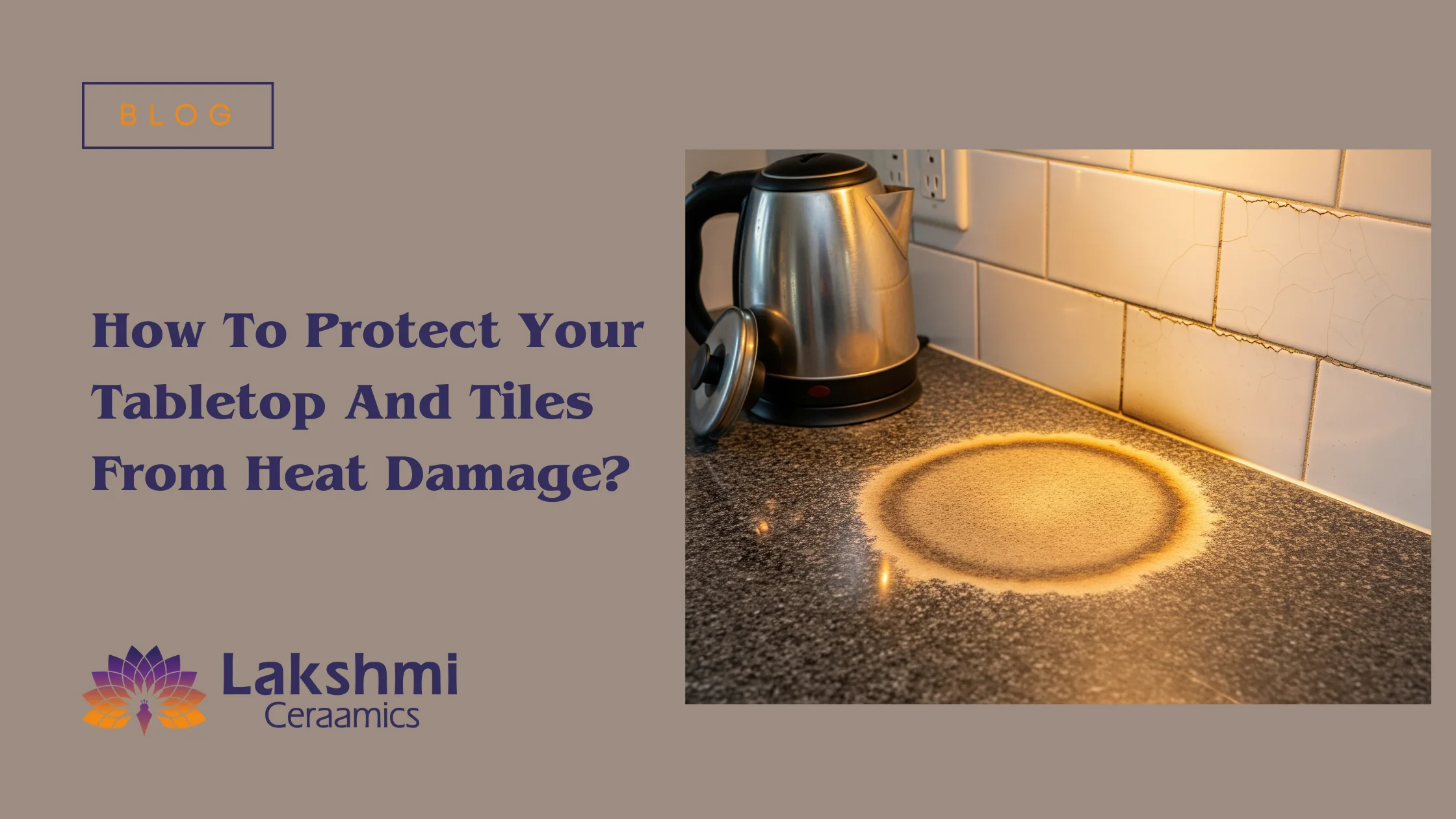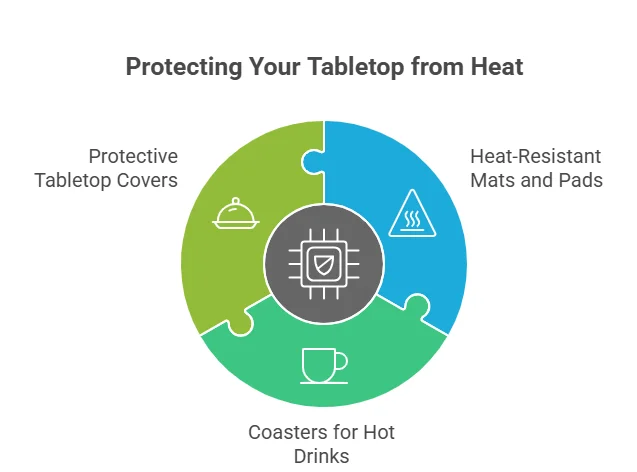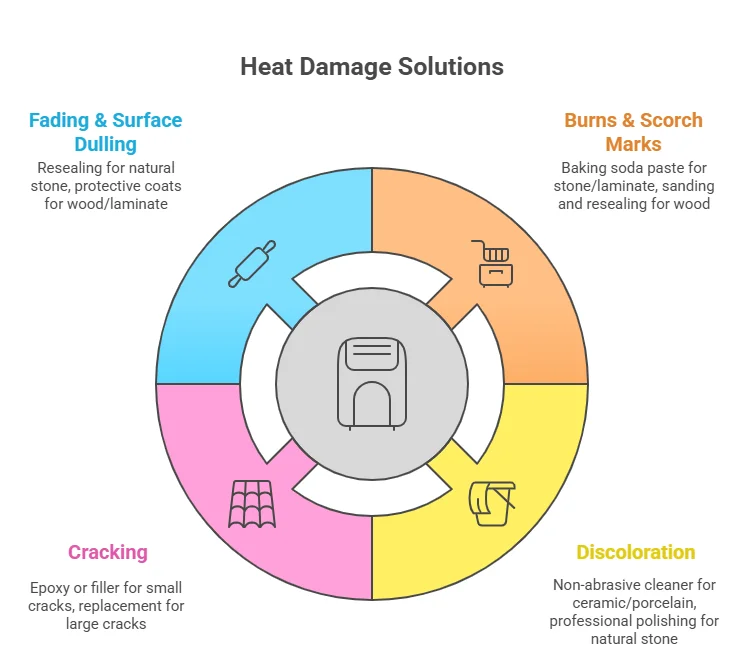
Heat damage is often preventable. But, when it does happen, it ruins the look of your kitchen tabletop, heat proof table top, and tiles as well as affects their overall lifespan.
Selecting materials renowned for their heat resistance, such as granite, heat proof tile, and vitrified tiles, is a great way to safeguard those surfaces. Using protective covers also helps prevent cracks and warping.
So, let us guide you through some effective techniques to keep your tabletops, tiles, and even a heat resistant backsplash away from scorch marks.
Why Protect Your Tabletop And Tiles From Heat?
Your tabletops and tiles can suffer serious consequences due to heat. It can be damaging to surfaces such as wood, laminate and stone.
When kitchen tabletops are subjected to heat, they can darken or develop rings, especially if hot pots or appliances are placed directly on them.
Those burn marks sometimes become permanent fixtures. Moreover, prolonged exposure to high temperatures may cause many types of materials to warp or bend, over time.
The thermal shock experienced by certain materials exposed to rapid temperature changes of intense heat and then, frigid cold can even result in cracking.
Measures To Shield Your Tabletop From Heat Damage

Use Heat-Resistant Mats And Pads
The easiest and most efficient way to shield your tabletop from heat damage is to utilise heat-resistant mats or pads.
Simply place these accessories under your hot cookware or appliances. It creates a physical barrier to preserve the structural integrity of your kitchen tabletop.
Trivets crafted from metal, ceramic or silicone materials are ideal for placing pans, as they are sturdy and can withstand high temperatures.
For safeguarding larger areas, consider silicone or cork mats. Some even come with anti-slip features to prevent dishes from moving. All of these are affordable choices that you can adopt without any trouble.
Have Coasters for Hot Drinks
We have all been there, guilty of keeping those steaming mugs directly onto the kitchen countertops without a second thought. But, this seemingly simple act has repercussions – discolouration!
Fortunately, coasters are here to help. Wooden or cork coasters are both stylish and functional. They can protect your surfaces from heat while complementing your home decor beautifully.
On the other hand, silicone coasters bring convenience and durability to the table. These coasters are incredibly easy to clean.
Invest In Protective Tabletop Covers
A protective tabletop cover is an important accessory you should think about adding to your kitchen setup. They are heat-resistant. There are many fantastic options available, created from materials like PVC.
The transparent design of the protective cover would not draw any attention. They, in fact, blend into your tabletop, keeping your kitchen looking the best as always.
Measures To Shield Your Tiles From Heat Damage
Consider Tile Protectors
Employing extra protective layers to the tiles subjected to significant heat exposure is a smart decision. You can install heat proof tile mats over tile surfaces, particularly for those in proximity to stoves, grills, or a heat resistant backsplash near the cooking area.
Applying a sealant to natural stone tiles not only defends against heat but also various other forms of damage.
Here heat, moisture and spills can be easily wiped away, reducing the risk of long-term issues. Sealants can protect outdoor tiles from ultraviolet rays as well.
Use Spacers
If tiles are not spaced properly during installation, they can become vulnerable to cracking from heat. This causes harm to the design and functional aspects of the space.
However, utilising spacers during installation can provide ample room for thermal expansion, especially in hilly areas.
Spacers, typically made from plastic, are small T-shaped or cross-shaped pieces inserted between the tiles for precise alignment and an orderly layout.
Their availability in different sizes ensures that they meet the specific requirements of any setup with ease. With spacers in place, you can create a seamless surface that also supports its longevity.
Shade Outdoor Tiles
Outdoor tiles, those basking in the sun’s rays for hours on end, can succumb to fading and warping due to heat exhaustion.
If your home features a patio or outdoor space, think about installing shade solutions such as sizable patio umbrellas.
They offer ample shade over your tiled areas and present a pleasant environment for you to hang out. Pergolas and awnings also provide substantial coverage for your outdoor tiles.
Strategically placing outdoor rugs or mats in such spots will go a long way in preserving the quality of the tiles. Also, it is better to choose tiles in lighter colours because they absorb less heat than the darker options.
Heat-resistant Materials
For Kitchen Tabletop
If a home renovation is in your plan, take that opportunity to explore heat-resistant materials for your countertops. Stainless steel, as a tabletop material, shines with heat resistance and brings a clean, modern touch to any kitchen.
Similarly, granite is a powerful contender, known for its ability to endure high temperatures. Another excellent material worth considering is quartz.
For Tiles
In areas like the kitchen backsplash or outdoor patio, where temperatures can soar, opting for heat resistant backsplash designs or fireproof tile is a proactive way to protect your home.
Vitrified tiles promise a combination of resilience and aesthetic appeal. With its resistance to heat and the non-porous surface, soapstone is the perfect material for outdoor kitchens and fireplaces.
Explore how vitrified tiles can align with your home’s aesthetic in our blogs.
Common Heat Damage Problems & How to Fix Them

Heat damages even such hard surfaces as tiles and countertops in the long run. Constant exposure can burn, crack, or fade pans, boiling pots, that are hot. The following are the most typical problems and ways you can solve them:
Burns & Scorch Marks
Burn spots on kitchen countertops are caused by hot cookware. The question that many homeowners pose is, How to remove burn marks on kitchen countertops? On stone or laminate, use a baking soda paste (baking soda and water together) and lightly vigorously scrub. In the case of wood countertops, light sanding and resealing is used to put back the surface.
Discoloration
Countertops and tiles can be subjected to extreme heat that causes them to fade or become discoloured. Tiles made of ceramics or porcelain may be cleansed normally using a non-abrasive tile cleaner, whereas natural stone might be in need of professional polishing in order to regain its shine.
Cracking
Thermal shock (sudden changes in temperature) may lead to cracks in stone countertops and floor/wall tiles. In the event of wondering how to repair heat-broken tiles, tiny hairline cracks can be patched with epoxy or filler. In bigger cracks, the easiest way is to replace the damaged tile. In the case of countertops, there are professional repair kits offered on quartz or granite cracks.
Fading & Surface Dulling
With time, tiles and countertops may fade in the presence of UV exposure and heat. The fix is to have natural stone surfaces resealed and the countertops made of wood or laminate covered with protective coats regularly. In the case of tiles, it is possible to re-glaze and restore the shine.
Pro Tip: Always use trivets, mats, or coasters to prevent direct heat exposure on counters and tiled surfaces. Prevention is easier (and cheaper) than repair.
Why Choose Lakshmi Ceraamics?
At Lakshmi Ceraamics, we proudly offer high-quality tabletops and tiles that are designed to handle the rigours of your daily life. You can enjoy surfaces that stand up to the heat, spills and splashes.
Our mission is deeply rooted in our commitment to deliver high-quality products across a wide variety of categories. Our extensive collection is designed to cater to diverse tastes and budgets.
From the minimalist beauty of modern aesthetics, characterised by their sharp, clean lines to the rich, timeless elegance of traditional designs, we strive to enhance all your spaces.
You can trust our team of design experts to help you find the right materials, styles and finishes that suit your lifestyle.
Visit our showroom today or check out our vast online selection. You are sure to find the most stunning tabletops and tiles ever!
Signs Your Tabletop or Tiles Are Heat-Damaged
Concerned that your day to day cooking activities are wearing down your surfaces? Here are the signs of knowing whether your countertop is heat damaged or your tiles are giving out the early signs:
-
Surface dullness – The once glossy finish looks faded or matte.
-
Cracks & fine lines – Tiny fractures appear due to thermal shock.
-
Discoloration or fading – Dark or light patches where hot pots were placed, sometimes even on a fireproof tile.
-
Circular rings – Marks left behind by heated pans, cups, or utensils.
-
Warping or uneven surface – Common in wooden or laminate countertops exposed to excess heat.
-
Spotting these early signs helps you prevent long-term structural damage.
Do’s & Don’ts for Heat Protection (Quick Checklist)
Do’s
-
Always use trivets, hot pads, or coasters under hot cookware.
-
Wipe spills quickly to avoid heat + liquid damage.
-
Seal natural stone countertops regularly to boost resistance.
-
Place silicone mats in high-use cooking zones.
Don’ts
-
Don’t place hot pans directly on tiles or countertops.
-
Don’t ignore small scorch marks – they can spread with time.
-
Don’t use harsh cleaners that strip protective coatings.
-
Don’t overload a single surface with repeated heat stress.
FAQs
Q1. How to know if my countertop is heat damaged?
Look for surface dullness, discoloration, cracks, or circular burn rings. These are early indicators of heat exposure.
Q2. Can tiles get heat damaged too?
Yes. Ceramic and porcelain tiles may crack under extreme, sudden heat. Stone tiles can fade or lose polish if exposed to constant high temperatures.
Q3. What’s the best way to protect my kitchen surfaces from heat?
Use trivets, heat pads, or coasters under all hot cookware and reseal natural stone surfaces as part of your care routine.
Q4. Can minor burn marks be repaired at home?
Yes. Light scorch marks on stone can sometimes be buffed or polished, while baking soda paste helps lift stains on certain surfaces. For deep cracks, professional repair is recommended.

Whatsapp Chatx
Hi! Click one of our representatives below to chat on WhatsApp or send us email to info@lakshmiceramics.in
 |
Mr. Ram S +91 96551 70955 |
 |
Mr. Martin +91 78688 86655 |
We will love to hear from you!
